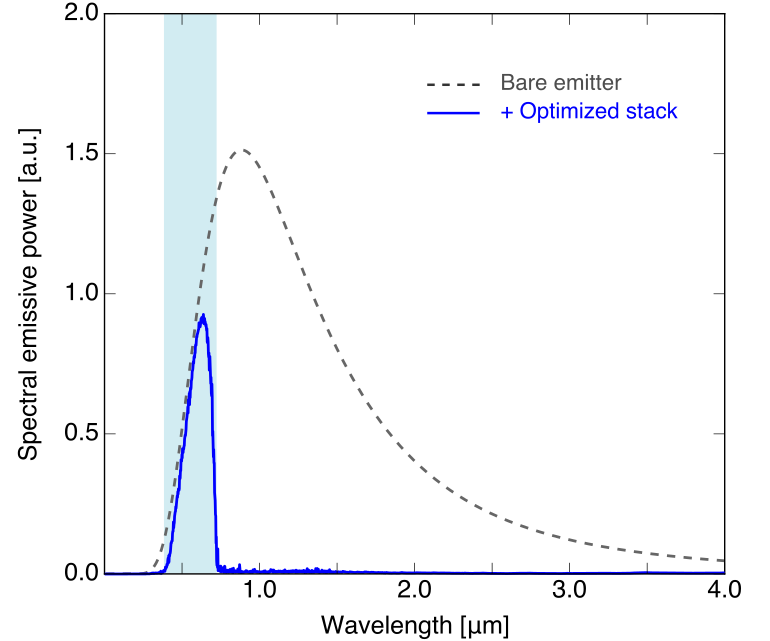Additional Materials
Our work [1] explores the potential of cold-side spectral engineering to tailor thermal radiation emitted by hot objects. In an example presented there, the layered nano-photonic structure was optimized for the quantity of interest expressed by Equation (2) of the paper. Naturally, it is possible to optimize for a different spectral profile, based on application and requirements. The purpose of this short document is to demonstrate that capability for a different figure of merit.
Here, we focus on maximizing the fraction of total consumed power that is emitted as visible light. Because incandescent light sources convert almost all of the supplied electrical power into light, the equivalent requirement is the fraction of total emitted light that falls in the visible spectrum. For the purposes of this brief analysis, we consider the visible spectrum to be 380nm-720nm. Following the same optimization scheme as in [1], and using the same set of four materials and refractive indices (bounded by n=1.46 and n=2.35), we reach a structure with the spectral profile shown in Figure 1.

Figure 1: The spectral emissive power of a tungsten emitter optimally enclosed by the structure designed to maximize the fraction of light in the visible spectrum. The power is integrated over all angles (hemispherical emission). Shaded area indicates the visible spectrum (380-720nm).
For this structure, the fraction of light emitted in the visible spectrum is 84%. To put this value in perspective, we examine a hypothetical structure that has the following reflectance properties:

where λ,θ are the wavelength and the angle of incidence with respect to the structure surface. This hypothetical structure has perfect transmission in the visible spectrum and reflects 99% of all other light (for all angles of incidence). When the identical thermal emitter as that of Fig. 1 (tungsten, 3100K) is optimally enclosed by such a structure, the fraction of light emitted in the visible spectrum is 84%. If such a hypothetical structure had 0.98 reflectance outside of the visible spectrum, the fraction of light emitted in the visible would be 73%. This analysis suggests that, as the fraction of light emitted in the visible is increased, it becomes exceedingly difficult for a broadband thermal emitter to reach complete visible light emission. Nevertheless, the multi-layered structure of Fig. 1 is already approaching performance comparable to such idealized filters given by expression (1).
An important feature of this optimized structure is that it closely follows the emission spectrum of the plain tungsten emitter for visible wavelengths. This ensures faithful reproduction of colors. Using the same approach as in [1], we calculate a color rendering index (CRI) value of 93. (Note that the structure was not explicitly optimized for CRI; in order to minimize emission beyond 720nm, the structure has a steep reflectance cutoff which affects the red part of the visible spectrum. Simply extending this boundary (to 750nm or slightly higher), could be the simplest way to improve the CRI.)
Another quantity of interest may be the luminous efficacy of this system. A black-body at 3000K(5800)K, with its spectrum truncated to 380-720nm wavelength range would have the luminous efficacy of 230(235) lum/W (equivalent to 34(34.5)%, when scaled by the maximum possible luminous efficacy for the peak wave- length of the eye’s sensitivity). In comparison to these values, the structure of Figure 1 above reaches luminous efficacy of 253 lum/W (equivalent to 37% when scaled).
The details of this structure (materials & thicknesses) can be found here (document hash).
References:
[1] O. Ilic, P. Bermel, G. Chen, J.D. Joannopoulos, I. Celanovic and M. Soljačić. Nature Nanotechnology (advanced online publication Jan. 11th 2016).